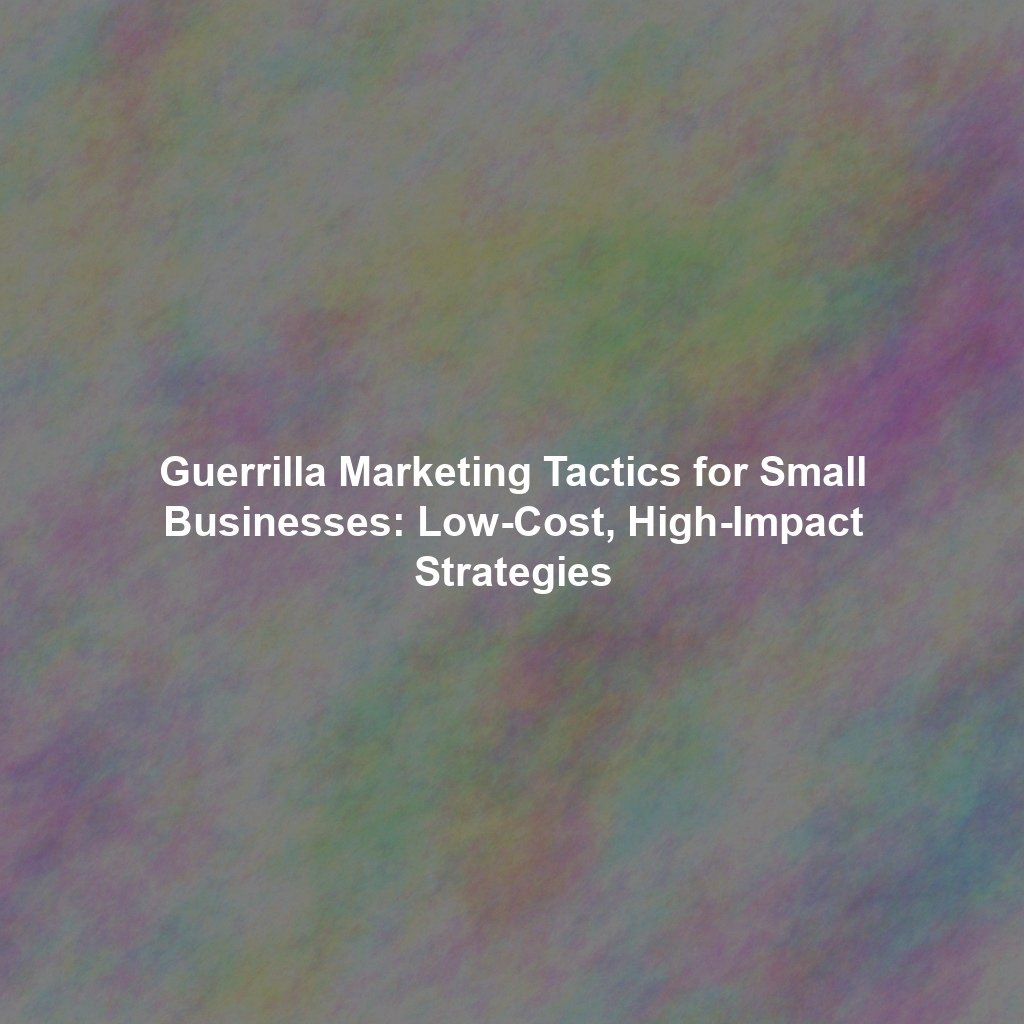In today’s digital age, it’s easy to get caught up in online marketing trends. But what if you’re a small business with a limited budget? The good news is, you don’t need deep pockets to make a big impact. Guerrilla marketing offers a powerful alternative, focusing on unconventional, low-cost tactics that create buzz and boost brand awareness through surprise, humor, and genuine human interaction. This guide explores practical, non-digital guerrilla marketing strategies that any small business can implement.
What is Guerrilla Marketing?
Guerrilla marketing, coined by Jay Conrad Levinson, is an advertising strategy that focuses on unconventional marketing tactics executed on a very small budget. Unlike traditional marketing, which relies on expensive media buys, guerrilla marketing leverages surprise, social interaction, and a bit of shock value to create memorable experiences and generate word-of-mouth marketing.
Key Principles of Guerrilla Marketing:
- Creativity Over Budget: Focus on innovative ideas rather than large sums of money.
- Surprise and Unpredictability: Catch your audience off guard and leave a lasting impression.
- Audience Engagement: Encourage interaction and participation, turning your target audience into brand advocates.
- Real-World Impact: Create tangible experiences that resonate with people in their everyday lives.
- Measurable Results: Track the impact of your campaigns, even if the metrics are unconventional (e.g., social media mentions, foot traffic).
Low-Cost, High-Impact Guerrilla Marketing Tactics
Here are some practical guerrilla marketing tactics that small businesses can use to generate buzz without breaking the bank:
1. Ambient Marketing
Ambient marketing involves placing ads in unexpected places, integrating them seamlessly into the environment. This could include:
- Stair Decals: Placing branded decals on staircases in high-traffic areas (with permission, of course!).
- Crosswalk Advertising: Using stencils and chalk to create temporary ads on crosswalks (ensure compliance with local regulations).
- Park Bench Ads: Attaching a small, creative ad to a park bench that subtly promotes your business. Imagine a sticker on a park bench suggesting “Need a rest? Our massages are just around the corner!”
2. Street Art and Graffiti Marketing
Transforming public spaces with eye-catching street art can generate significant attention. Remember to always obtain necessary permits and approvals to avoid legal issues.
- Chalk Art Murals: Creating temporary chalk art murals related to your business on sidewalks.
- Stencil Graffiti: Using stencils and environmentally friendly paint to create branded messages on walls (again, with permission!).
3. Flash Mobs and Public Performances
Organizing a flash mob or public performance related to your business can create a viral sensation. Consider:
- Pop-Up Dance Performances: Hiring dancers to perform a short, choreographed routine in a public space, ending with a clear message about your business.
- Interactive Street Theatre: Creating a short, engaging play or skit that highlights the benefits of your product or service.
4. Stickers and Postering
This classic tactic remains effective when done creatively. Focus on high-traffic areas and design stickers that are visually appealing and memorable.
- Die-Cut Stickers: Creating unique sticker shapes related to your brand.
- Strategic Placement: Placing stickers in unexpected but relevant locations (e.g., on coffee shop tables for a local bookstore).
- QR Code Integration: Include a QR code on your posters or stickers that directs users to your website or a special offer.
5. Free Samples and Product Demonstrations
Offering free samples or product demonstrations can be a powerful way to attract new customers. Think outside the box:
- Pop-Up Sample Stations: Setting up temporary sampling stations in busy locations.
- Partnerships with Local Businesses: Collaborating with other businesses to offer samples or demonstrations of your products within their stores. For example, a bakery could offer free samples of their new bread at a local coffee shop.
6. Community Events and Sponsorships
Participating in local events and sponsoring community initiatives demonstrates your commitment to the community and builds brand loyalty.
- Local Festivals and Fairs: Setting up a booth at local festivals and fairs to promote your business.
- Charity Events: Sponsoring or participating in local charity events.
7. Reverse Graffiti (Clean Advertising)
Reverse graffiti involves cleaning a dirty surface to create an image or message. It’s environmentally friendly and can be highly effective, but again, check local regulations.
8. Word-of-Mouth Marketing and Influencer Outreach (Offline)
While online influencers are common, consider the value of building relationships with key figures within your local community.
- Local Experts: Engaging with local experts or community leaders who can vouch for your product or service.
- Community Activists: Partnering with local activists whose values align with your brand.
Measuring the Success of Your Guerrilla Marketing Campaign
While guerrilla marketing focuses on unconventional tactics, it’s still important to track your results. Consider these metrics:
- Social Media Mentions: Monitor social media for mentions of your brand or campaign.
- Foot Traffic: Track changes in foot traffic to your business after implementing a guerrilla marketing tactic.
- Website Traffic: Monitor website traffic to see if your campaign is driving more visitors to your site.
- Sales: Track sales to see if your campaign is directly contributing to increased revenue.
- Media Coverage: Did your campaign get picked up by local news outlets?
Conclusion
Guerrilla marketing provides a powerful way for small businesses to stand out from the crowd without spending a fortune. By embracing creativity, understanding your target audience, and focusing on engagement, you can create memorable experiences that generate buzz, build brand awareness, and ultimately drive sales. Remember to always comply with local regulations and be mindful of your brand image. Get creative, take risks, and have fun – that’s the spirit of guerrilla marketing!
 Skip to content
Skip to content

